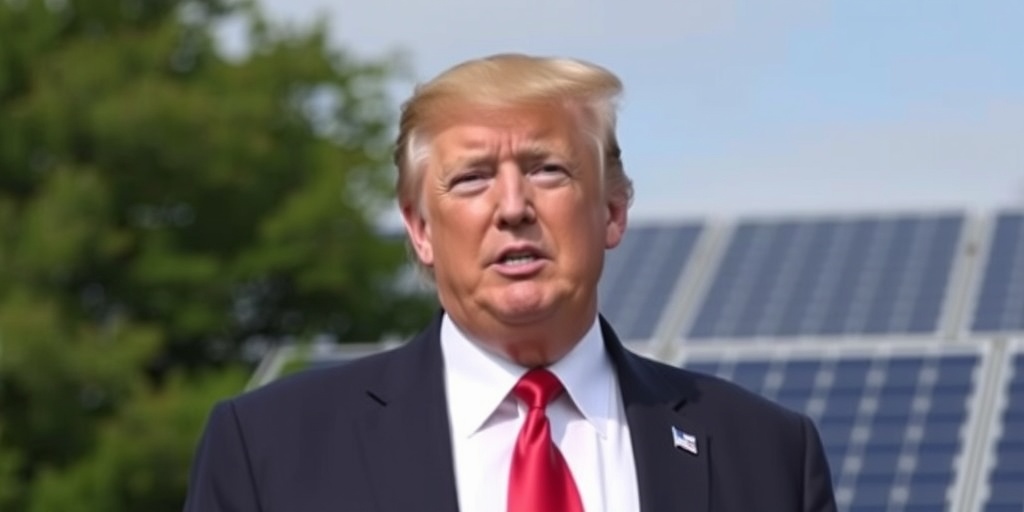Now Reading: Trump Criticizes Solar Energy, Yet U.S. Sees Major Gains by 2024
-
01
Trump Criticizes Solar Energy, Yet U.S. Sees Major Gains by 2024
Trump Criticizes Solar Energy, Yet U.S. Sees Major Gains by 2024

U.S. Solar Energy Capacity Hits Record High Amidst Controversy
In a significant development for renewable energy, the U.S. power grid established more solar energy generation capacity in 2024 than any other energy source in over twenty years. This revelation comes from a recent report published by the Solar Energy Industries Association in conjunction with Wood Mackenzie, a prominent research firm, highlighting the growing momentum of solar energy in the United States.
The report indicates that approximately 50 gigawatts of new solar capacity was added in the past year, emphasizing the technology’s role as a leader in electricity generation. This surge in solar energy adoption coincides with a wave of criticism directed towards renewable energy sources by the newly appointed U.S. Energy Secretary, Chris Wright. Just a day before the report’s release, Wright expressed his discontent regarding the capacity of solar and wind energy to meet global electricity demands, suggesting that their increased deployment has been a contributing factor in rising energy costs.
Wright’s comments, made during the CERAWeek conference in Houston, reflect a broader skepticism among certain political factions regarding renewable energy solutions. Alongside former President Donald Trump, Wright has pledged to dismantle many climate and energy policies implemented during the Biden administration, which championed renewable resources as pivotal in the fight against climate change.
The energy secretary stated, "Beyond the obvious scale and cost problems, there is simply no physical way wind, solar, and batteries could replace the myriad uses of natural gas." Despite his assertions, the growing consensus among advocates for clean energy is that the expansion of solar power and battery storage is not only inevitable but also necessary to cater to the increasing electricity requirements of various sectors, including data centers that fuel advancements in artificial intelligence.
Prominent figures within the renewable energy sector, such as Abigail Ross Hopper, president and CEO of the Solar Energy Industries Association, remain optimistic about the future of solar energy. During the CERAWeek conference, Hopper emphasized that deploying solar and storage solutions is the most efficient and cost-effective approach to meeting the rising energy demands. Responding to the need for increased electricity, she said, “There’s wild agreement that in order to do that, we have to have enough electricity, and there are facts that show that the fastest way to do that and the cheapest way is through deployment of solar and storage.”
Moreover, John Ketchum, CEO of NextEra Energy, the nation’s largest producer of renewable energy, affirmed solar’s ability to deliver speedy and economical electricity generation. However, he acknowledged the challenge posed by rising electricity costs, which have been a concern over the past few years. Factors contributing to these price increases include the spike in oil and natural gas prices following Russia’s invasion of Ukraine in 2022, alongside the need for significant upgrades to the electrical grids that utilities had delayed for years.
Wright’s perspective on the issue further elaborates on the complexities surrounding the integration of renewable energies. He noted, “Wind and solar, the darlings of the last administration and so much of the world today, supply roughly 3 percent of global primary energy. Everywhere wind and solar penetration have increased significantly, prices on the grid went up, and stability of the grid went down.” This assertion highlights a contentious debate within the energy discourse about the viability of renewable energy sources in providing a stable and affordable electricity supply.
Despite these challenges, statistics indicate that electricity rates reached historic highs in 2024, with the average monthly bill for a typical household using 1,000 kilowatt-hours rising by approximately 4 percent to $162.60 in December, up from $156.90 the previous year. As demand for electricity is projected to increase significantly in the coming years—by approximately 55 percent over the next two decades, with data centers contributing substantially to this demand—energy experts stress the need for a balanced approach that prioritizes affordability, reliability, and safety in energy production while also addressing climate change concerns.
In discussions about the future of energy, former Energy Secretary Ernest Moniz remarked on the potential hurdles ahead, recognizing the necessity of transitioning to a low-carbon future. “There are going to be bumps in the road,” Moniz noted during a panel at CERAWeek, encapsulating the dual challenge of enhancing energy capacity while adhering to environmental goals.
The evolving landscape of American energy production symbolizes a critical juncture in the nation’s approach to meeting its growing energy demands while grappling with the implications of climate change and the legacy of prior administrations. As the discourse continues, the intersection of solar power’s potential and skepticism regarding renewable resources remains at the forefront of energy policy discussions.
Stay Informed With the Latest & Most Important News
Previous Post
Next Post
-
 01New technology breakthrough has everyone talking right now
01New technology breakthrough has everyone talking right now -
 02Unbelievable life hack everyone needs to try today
02Unbelievable life hack everyone needs to try today -
 03Fascinating discovery found buried deep beneath the ocean
03Fascinating discovery found buried deep beneath the ocean -
 04Man invents genius device that solves everyday problems
04Man invents genius device that solves everyday problems -
 05Shocking discovery that changes what we know forever
05Shocking discovery that changes what we know forever -
 06Internet goes wild over celebrity’s unexpected fashion choice
06Internet goes wild over celebrity’s unexpected fashion choice -
 07Rare animal sighting stuns scientists and wildlife lovers
07Rare animal sighting stuns scientists and wildlife lovers




















